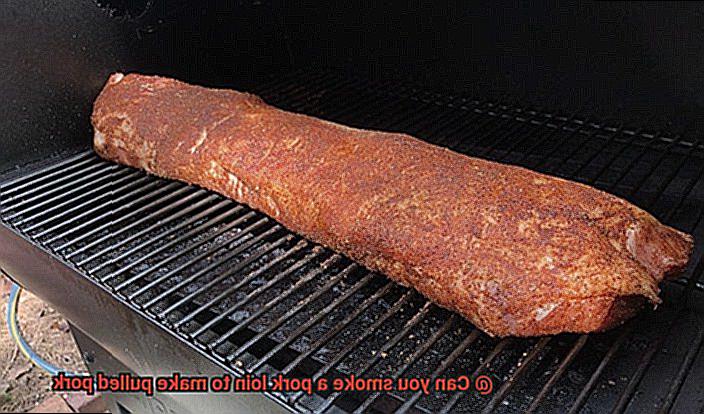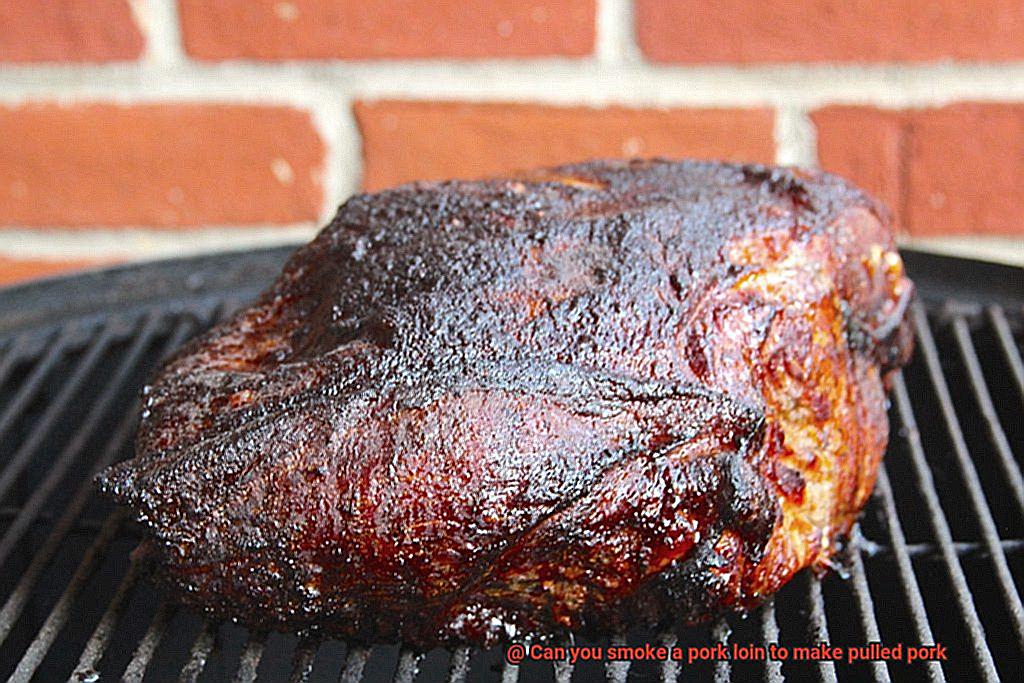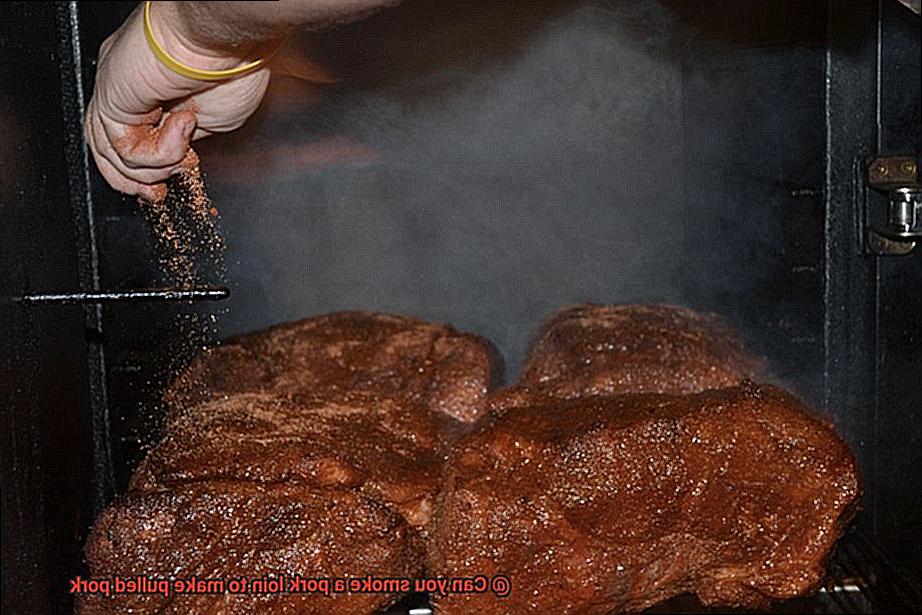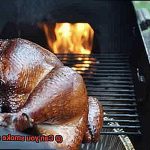Do you crave the smoky, succulent goodness of pulled pork? If you’re a meat lover, chances are you do. But can you achieve that delicious texture and flavor using pork loin?
Pork loin is a lean and tender cut from the hog’s back. While it’s commonly used for roasting, some wonder if it’s suitable for smoking and making pulled pork. This question has sparked a heated debate among barbecue enthusiasts.
Critics argue that pork loin is too lean, lacking the necessary fat marbling to produce juicy and flavorful meat. They claim it will result in dry and tasteless pulled pork.
However, others contend that with the right technique and seasoning, pork loin can be transformed into mouth-watering pulled pork. They maintain that this cut can yield deliciously tender results.
In this blog post, we’ll explore this controversy in depth. We’ll weigh the pros and cons of using pork loin, discuss various preparation methods, and recommend ideal seasonings to elevate your pulled pork game.
So, whether you’re a seasoned smoker or new to the game, join us as we uncover all the secrets of smoking pork loin for ultimate pulled pork perfection.
Contents
Differences between Pork Loin and Other Cuts for Pulled Pork
When it comes to making pulled pork, choosing the right cut of meat is essential. Pork loin is a lean and tender cut that is commonly used for grilling or roasting. However, if you’re wondering whether it’s possible to smoke a pork loin to make pulled pork, the answer is yes, but it may not be the best choice.
Pork shoulder or Boston butt are preferred cuts for making pulled pork because they have more fat and connective tissue. These elements help keep the meat moist and flavorful throughout the lengthy cooking process. On the other hand, pork loin has less fat and connective tissue, which can lead to dry and tough meat if overcooked. Plus, it’s a smaller cut of meat, which might not be enough to feed a large group.
That being said, if you’re determined to try smoking a pork loin for pulled pork, there are a few things you can do to ensure it turns out deliciously tender and juicy. Injecting the pork loin with a flavorful liquid before smoking it will add moisture and extra flavor. Smoking at a low and slow temperature between 225-250°F will break down the connective tissue in the meat and make it easy to pull apart. This process can take several hours depending on the size of the pork loin.
While smoking a pork loin for pulled pork can result in different texture compared to using pork shoulder or Boston butt, there are ways to mitigate this. Wrapping the pork loin in bacon or another fatty meat before smoking will help keep the meat moist and add extra flavor. Another option is to inject the meat with a marinade or brine to add moisture and flavor.
Preparing the Pork Loin for Smoking
Get ready to wow your guests with a succulent and flavorful smoked pork loin. The first step towards achieving perfection is to select the right cut of meat. Look for a well-marbled pork loin with plenty of fat that will keep the meat moist during the smoking process. Opt for a boneless pork loin as it cooks more evenly and is easier to slice.
Trimming excess fat and silver skin from the pork loin is essential to prevent a greasy or tough finished product. Use a sharp knife to remove any unwanted fat and silver skin, ensuring not to remove too much meat. You’ll be rewarded with perfectly cooked, tender pork.
Now it’s time to add some flavor. The dry rub is what makes all the difference. Whether you prefer a sweet, spicy, or savory rub, most contain a combination of salt, sugar, paprika, garlic powder, and black pepper. Be generous when applying the dry rub, making sure to cover every inch of the pork loin.
Let your pork loin rest before smoking. This allows the flavors in the rub to penetrate into the meat. While it’s resting, prepare your smoker by setting it to 225-250°F and adding wood chips or chunks for smoke flavor. Popular choices for smoking pork include hickory, applewood, and cherry wood.
Now it’s time to smoke that pork loin. Place your seasoned pork loin in the smoker and let it cook low and slow for several hours until it reaches an internal temperature of 145°F. Baste the meat with any leftover marinade or juices from time to time for added moisture.
When your pork loin is ready, allow it to rest for at least 10-15 minutes before slicing. This allows the juices to redistribute throughout the meat for a mouthwatering finished product.
The Importance of Low and Slow Temperature for Smoking
Then, it’s time to embrace the low and slow method. When it comes to smoking meat, temperature and time are key factors that determine the final taste and texture of your dish. And when it comes to making pulled pork, a low and slow cooking temperature is essential.
What exactly does low and slow mean? It involves cooking the pork loin at a temperature between 225-250°F for an extended period, typically around 6-8 hours. This method allows the meat to cook slowly, breaking down the collagen and connective tissues in the pork loin. The result? Tender, juicy meat that shreds effortlessly for mouthwatering pulled pork.

But why is a low and slow temperature so crucial? When you cook your pork loin at high temperatures, the outer layer may become dry and tough while the inside remains undercooked. That’s definitely not what you want when aiming for perfect pulled pork. By keeping the temperature low and steady, you ensure that every inch of the meat cooks evenly, resulting in a perfectly cooked and tender end product.
Another benefit of using a low and slow cooking temperature is that it allows the smoke to penetrate the meat fully. This infuses the pork with rich smoky flavor that will make your taste buds sing. And since pulled pork is often served without any sauce or seasoning on top, this smoky flavor takes center stage.
So how do you achieve this low and slow cooking temperature? It’s pretty simple. Set your smoker to a temperature between 225-250°F, use wood chips or chunks for smoke flavor, and let it go for several hours. Keep an eye on the temperature throughout the cooking process to ensure it stays within the desired range.
Injecting the Pork Loin with Flavorful Liquid
Injecting your pork loin with flavorful liquid is the secret to creating juicy, tender, and mouth-watering pulled pork. As an expert in this technique, I can assure you that it’s a game-changer for your BBQ game.
To get started, you’ll need a meat injector. This nifty tool allows you to inject marinades, brines, or other flavorful liquids like apple juice, vinegar, or beer directly into the meat. Inject the liquid slowly and evenly throughout the pork loin to ensure it’s fully flavored and moist.
But be careful not to overdo it. Over-injecting can cause a mushy texture and uneven cooking. Aim to inject no more than 10% of the weight of the meat in liquid.
Before injecting, generously season your pork loin with a dry rub or spice blend to enhance its flavor further. Apply the seasoning on all sides, including the ends, for maximum flavor impact.
Now it’s time to smoke. Preheat your smoker to 225-250°F and place the pork loin with indirect heat. Use a meat thermometer to monitor the internal temperature and cook until it reaches around 195°F for perfectly tender pulled pork.
How Long Does it Take to Smoke a Pork Loin?
As an expert in all things smoked meat, I’m here to guide you through the process of smoking a pork loin to perfection. The first thing to consider is the cooking time, which can vary depending on the size of the pork loin and the temperature at which it’s being smoked.
Let’s start with size. For a 3-4 pound cut, plan for around 4-5 hours of smoking time. However, if you’re dealing with a larger 6-7 pound pork loin, expect closer to 6 hours of smoking time. But don’t worry, it’s worth the wait.
Now, let’s talk temperature. Keeping your smoker at a consistent temperature of 225-250 degrees Fahrenheit will ensure that your pork loin cooks evenly and comes out tender and juicy. However, different smokers may require different cooking times. For instance, a pellet smoker may cook the meat faster due to its more consistent temperature control. On the other hand, a traditional wood smoker may take slightly longer.
But how do you know when your pork loin is ready? The answer is simple: use a meat thermometer. Checking the internal temperature of your pork loin is key to ensuring that it’s cooked all the way through and ready for pulling. Once it reaches an internal temperature of around 200-205 degrees Fahrenheit, your pork loin should be perfectly tender and ready to pull apart.
Different Texture from Other Cuts of Meat
While it may have a leaner and firmer texture, smoking a pork loin can offer a unique texture compared to other cuts of meat.
To achieve the desired tenderness for pulled pork, proper seasoning and brining are crucial. This not only enhances the flavor but also helps to maintain moisture in the meat. Additionally, utilizing a low and slow smoking method can break down the connective tissues and fibers in the meat, resulting in a tender texture that will make your taste buds sing.
It’s worth noting that smoking a pork loin may not yield as much pulled pork as a larger cut like a shoulder or butt. However, it’s a fantastic option for those who prefer a leaner cut of meat or want to try something different from the traditional pulled pork.
But why stop there? Consider experimenting with other cuts of meat for unique textures. For example, beef brisket offers a rich and smoky flavor with a melt-in-your-mouth texture when cooked low and slow. Or try lamb shoulder for a tender and succulent texture that will take your taste buds on a flavor journey.
Tips for Making Delicious Pulled Pork with Pork Loin

Look no further than using pork loin as your meat of choice. While it may be leaner than traditional cuts like pork shoulder or butt, with the right preparation and techniques, you can still achieve mouthwatering and tender pulled pork.
Step 1: Choose the Right Cut of Pork
When selecting your pork loin, look for a well-marbled piece with some fat on it. This will help keep the meat moist during smoking and prevent it from drying out.
Step 2: Brine the Pork
To further enhance the tenderness and flavor of your pork loin, consider brining it before smoking. A simple brine solution of water, salt, sugar, and spices can work wonders in keeping the meat juicy and flavorful. For added depth of flavor, try experimenting with ingredients like apple cider vinegar, garlic, or herbs.
Step 3: Season with a Dry Rub
A flavorful dry rub is key to adding complexity to your pulled pork. Create your own blend using a mix of spices like paprika, chili powder, cumin, and brown sugar. Make sure to rub the mixture all over the pork loin, getting into every crevice and fold in the meat.
Step 4: Smoke Low and Slow
Low and slow is the name of the game when it comes to tender pulled pork. Set your smoker to a temperature between 225-250°F and smoke the pork loin for several hours until it reaches an internal temperature of 195-200°F. This will allow the meat to break down and become tender enough to pull apart with a fork.
Step 5: Rest Before Pulling
Once your pork loin is finished cooking, let it rest for at least 15-20 minutes before pulling it apart. This will allow the juices to redistribute throughout the meat and make it easier to shred.
Additional Tips:
ZWXz_q1JUn0″ >
Conclusion
In the world of barbecue, the question of whether a pork loin can be smoked to make pulled pork has ignited a fiery debate. Some argue that this lean cut of meat lacks the essential fat marbling needed to produce succulent and flavorful meat. However, others swear by their techniques and seasoning to transform pork loin into mouth-watering pulled pork.
When it comes to making pulled pork, selecting the right cut of meat is crucial. However, if you’re determined to smoke a pork loin for it, there are several things you can do to ensure that it turns out tender and juicy. Injecting the pork loin with a delicious liquid before smoking will add moisture and flavor. Cooking at low temperatures between 225-250°F will break down the connective tissue in the meat while making it easy to pull apart.
While using pork loin for pulled pork may result in different textures compared to other cuts like Boston butt or pork shoulder, there are ways to overcome this challenge. Wrapping your pork loin in bacon or another fatty meat before smoking will help keep it moist and add extra flavor.
Ultimately, whether you choose to use a pork loin or another cut for your pulled pork depends on your personal preference. With proper preparation techniques and attention paid to cooking temperature and time, you can achieve mouth-watering results no matter which cut of meat you use.






